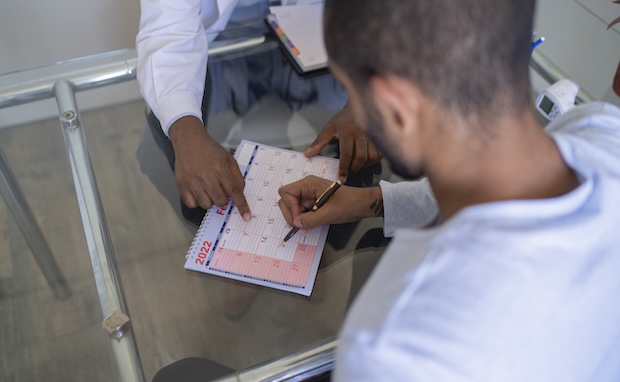Key Points:
- It takes five days for half of the medication to leave your body (the half-life).
- It typically takes about four to five weeks (roughly 30 days) for tirzepatide to be completely eliminated from your system.
- It will likely take longer than 30 days to start feeling a difference from how you felt while taking the medication.
Some medications leave your system in a matter of hours, but tirzepatide – the active ingredient in Mounjaro® and Zepbound® – is designed to stick around.
Whether you are pausing medication for an upcoming surgery, planning a pregnancy, or simply struggling with side effects, it is normal to feel anxious about how long the drug will remain active in your body. While the simple answer is that it takes about one month, your body's unique metabolism, your kidney function, and why you are stopping in the first place all impact how long it will take to notice a difference coming off tirzepatide.
Here is an evidence-based breakdown of how long tirzepatide stays in your system and what to expect during the process.
How long does tirzepatide stay in your system?
To understand how long tirzepatide lasts, you have to look at its "half-life." A half-life is the time it takes for the amount of a drug in your body to be reduced by 50%.
Tirzepatide has a half-life of approximately 5 days.
This is why you only need to take the injection once a week. By the time your next dose is due (every seven days), you still have a significant amount of medication working in your body. This overlap helps maintain steady blood sugar and appetite control.
However, when you stop taking it, the math works like this:
- 5 days after last dose: ~50% remains
- 10 days after last dose: ~25% remains
- 15 days after last dose: ~12.5% remains
- 20 days after last dose: ~6.25% remains
- 25-30 days after last dose: Less than 3% remains (clinically considered "cleared")
For most people, the drug is effectively gone from the system after 30 days.
Does dosage matter?
While the time it takes to clear (the half-life) remains consistent regardless of your dose, people on higher doses (like 10mg, 12.5mg, or 15mg) have a higher starting amount in their system. While the 30-day rule generally applies, you might feel the lingering biological effects – like appetite suppression – slightly longer than someone stopping a 2.5mg dose simply because you started with a higher concentration.
Factors that influence clearance time
You might read that factors like age, weight, or kidney health change how fast drugs leave your body. With tirzepatide, the evidence is surprisingly different.
Kidney & liver function
For many medications, if your kidneys or liver aren't working perfectly, the drug stays in your system much longer. However, clinical studies demonstrate that renal (kidney) impairment – from mild to severe – has no clinically relevant effect on how tirzepatide is cleared.
This means that even if you have kidney issues, you can generally expect the medication to leave your system in the same ~30-day window as someone with healthy kidneys. (However, always consult your doctor, as the side effects like dehydration can still affect your kidneys).
Age & body weight
Similarly, research indicates that age, body weight, and gender do not have a clinically significant impact on the pharmacokinetics (movement of drugs through the body) of tirzepatide. The 5-day half-life is a reliable standard for the vast majority of patients.
Why you might need to stop tirzepatide
Knowing what to expect going off tirzepatide is useful, but knowing why it matters is critical. Here are the three most common scenarios where timing is everything.
1. Surgery & anesthesia
This is currently one of the most urgent reasons to stop Mounjaro or Zepbound. Because GLP-1 medications like tirzepatide delay gastric emptying (keeping food in your stomach longer), there is a risk that you could still have food in your stomach during surgery, even if you fasted. This increases the risk of aspiration (inhaling food/liquid into the lungs) while under anesthesia.
The American Society of Anesthesiologists (ASA) recommends the following for patients on weekly GLP-1 agonists:
- Stop taking the medication for one week prior to elective procedures
- If you have severe nausea, vomiting, or abdominal pain on the day of surgery, the procedure may need to be delayed
Of course, you should consult both your prescribing provider and your surgeon for guidance specific to your particular situation.
2. Pregnancy & contraception
If you are planning to become pregnant, your doctor will likely recommend a "washout period." Because it takes about 30 days for the drug to clear, many providers suggest stopping at least one to two months before trying to conceive to ensure the drug is completely out of your system.
Crucial warning: Tirzepatide can actually make oral contraceptives (birth control pills) less effective. The labeling advises patients using oral contraceptives to switch to a non-oral method (or add a barrier method like condoms) for 4 weeks after starting and 4 weeks after every dose increase.
3. Managing side effects
If you are stopping due to severe nausea, vomiting, or other GI issues, you likely want to know when you’ll start feeling better.
“Most patients start to feel acute improvements quickly within the first 5-7 days of stopping the medication,” says Rita Faycurry, RD. “Any lingering sensitivity usually fades completely within that 30-day clearance window.”
Drug testing & tirzepatide
A common question is whether tirzepatide shows up on employer drug screenings.
The short answer is no. Standard 5-panel, 10-panel, or 12-panel drug screens look for controlled substances like amphetamines, opioids, and benzodiazepines. Tirzepatide is a peptide (a chain of amino acids) and does not chemically resemble these drugs. It requires a highly specialized and expensive test to detect, which is virtually never used in standard employment or athletic screening.
What happens when you stop?
Once the medication leaves your system, your body's natural hunger cues will return – often with intensity.
- Rebound hunger: As the appetite-suppression effects fade (usually noticeable 1-2 weeks after the last dose), many people experience "food noise" returning.
- Blood sugar: Without the medication helping your pancreas release insulin, blood sugar levels can rise again if lifestyle changes aren't maintained.
This transition period is where working with a registered dietitian becomes vital.
“While going off tirzepatide can feel intimidating, especially if you’ve lost a significant amount of weight, you will quickly find your footing,” says Rita Faycurry, RD. “It’s important to work with a registered dietitian who can help you adjust your intake and meal timing to manage the return of hunger cues without regaining the weight you lost.”
Final Thoughts
Tirzepatide is a long-acting medication that requires patience. While the half-life is 5 days, you should plan for a full month (30 days) for the drug to be completely eliminated from your body.
Whether you are pausing for surgery, pregnancy, or personal reasons, knowing this timeline helps you plan safely. Because the drug leaves your system gradually, your hunger will likely return gradually as well – giving you a window of opportunity to solidify your nutrition plan.
You don't have to navigate this transition alone. A registered dietitian can help you create a strategy to maintain your health goals, even when you're off the medication.
Connect with a registered dietitian covered by your health insurance today.
Frequently Asked Questions
How long after stopping tirzepatide will my appetite return? Most people notice their appetite slowly returning about 7 to 10 days after their last missed dose. The "food noise" (constant thoughts about food) tends to return more strongly 2 to 3 weeks after stopping as the drug levels in your body drop below effective therapeutic amounts.
Can I just stop tirzepatide cold turkey? Yes, you can stop tirzepatide abruptly without dangerous withdrawal symptoms (unlike opioids or benzodiazepines). However, stopping "cold turkey" can lead to sudden blood sugar spikes or rapid weight regain. Consult your healthcare provider for a plan, which may involve tapering down or switching to a different management strategy.
Do I need to wait 30 days to switch to Ozempic or Wegovy? Not necessarily. Because tirzepatide and semaglutide (Ozempic/Wegovy) work on similar pathways, doctors often perform a direct switch or have you wait just one week (one missed dose) before starting the new medication. Always follow your doctor's specific switching instructions to avoid severe stomach upset.
Will drinking water help flush tirzepatide out faster?
No. Hydration is excellent for your health and can help manage side effects like constipation or nausea, but it does not speed up the metabolic breakdown of the drug. Your body clears tirzepatide through peptide metabolism, a process that happens at a set speed regardless of water intake.
The views expressed by authors and contributors of such content are not endorsed or approved by Fay and are intended for informational purposes only. The content is reviewed by Fay only to confirm educational value and audience interest. You are encouraged to discuss any questions that you may have about your health with a healthcare provider.
Sources
Fay Nutrition has strict sourcing guidelines and relies on peer-reviewed studies, academic research institutions, and medical associations. We avoid using tertiary references.
- Consensus-Based Guidance on Preoperative Management of Patients on Glucagon-Like Peptide-1 (GLP-1) Receptor Agonists American Society of Anesthesiologists
- Pharmacodynamics, pharmacokinetics, safety and tolerability of the novel dual glucose-dependent insulinotropic polypeptide/glucagon-like peptide-1 agonist RG7697 after single subcutaneous administration in healthy subjects - Diabetes, Obesity and Metabolism
- Mounjaro (tirzepatide) injection, for subcutaneous use (2022)
- Zepbound (tirzepatide) injection, for subcutaneous use (2023)











